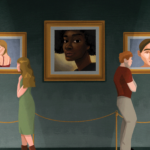Canada needs to have a conversation about love

I’ve just gone through a break-up. It’s 2 a.m. and my computer screen casts light on my face in the darkness of my room. A past lover is posting selfies on Instagram. While he’s living his best life, I’m trying to finish a 2,000-word feature for the Review. I’m grappling with heartache and asking myself if any of it was real. Did he care at all? Staring at the blank screen, I wonder why heartbreak always hits hardest when you have a deadline.
We romanticize love endlessly in movies, books, and songs, but why don’t we write about love in journalism? I’ve been swimming in fantasies of love for as long as I could dream. Yet, it cuts like a knife. Love walks the edge between warm feelings and an all-consuming ache: wanting to be near them until the shattering realization that they’ve drifted away leaves your chest a tender, hollow shell. Surely there’s a story there, right?
In Canadian journalism, love is often confined to major events like Valentine’s Day, high-profile weddings, and historical anniversaries. Simone Paget, a journalist and host of the podcast We’re Never Doing This Again, notes that while there is “plenty of reporting on younger singles and married and divorced people,” there’s a lack of stories about love outside of these conventional narratives. “I would love to see more stories about women in their forties and older finding love in midlife and beyond,” she says. “Stories about older people tend to be focused on divorce and its aftereffects.”
There are exceptions, however, as significant events sometimes evoke broader conversations about love in Indigenous traditions, immigrant experiences, 2SLGBTQIA+ relationships, or intercultural unions. But in general, Canadian journalism treats love as a topic that belongs in lifestyle columns rather than a topic worthy of deeper exploration.
Canadian journalism prioritizes sharing important, time-sensitive information in a way that is easy to understand. Journalists strive to be objective, leaving aside their personal feelings and opinions to serve as the voice of reason. Often, this comes at the cost of connectivity to readers.
But journalists are human, and life is messy. Love deepens our connection to stories, making them more personal, emotional, and memorable. Stories about love, whether romantic, familial, or platonic, can humanize complex issues like immigration, conflict, or social justice, making them more relatable.
As Paget points out, “Love and heartbreak are universal experiences. Writing openly about them brings the human element to the forefront. It fosters empathy and connection with the reader—something we could use more of in a world where many of us feel disconnected and numbed by the increasingly fast-paced and traumatic news cycle.”
Love informs the stories we tell, and it can also be the story itself. But what do journalists risk when they incorporate love and emotion into their work?
“They risk being criticized for not being objective or unbiased,” Paget explains. “In the kind of work I do, which involves writing about personal experiences publicly, they also compromise their privacy to a certain extent. Sharing your heartbreak in a public forum makes you open to scrutiny from past and future partners.”
But the reward can outweigh the risk. “What you gain is a deeper connection with the reader,” Paget says. “For me, the trade-off is worth it. The stories where I’ve allowed myself to be vulnerable when sharing my experiences with love and heartbreak are often the ones where I get the most positive feedback from readers.”
Maybe that’s exactly what Canadian journalism needs—more stories that acknowledge the profound and messy ways that love shapes our everyday lives. More stories that reveal how these experiences aren’t one-dimensional.
In the end, what’s more universal than love?
About the author
Angel is a fashion stylist in her final year of her Bachelor of Journalism, focusing on arts, fashion and culture. She’s launched the first issue of WDYM WHACK, a fashion magazine that aims to show fashion in cities worldwide. Driven by the desire to bring the stories of the Black diaspora to the forefront of fashion and journalism, her writing has been featured in T-Dot, CanCulture, FORM and more. When she’s not writing or playing with clothes, you can find her dreaming big, with a bag of Kinder Buenos by her side.






